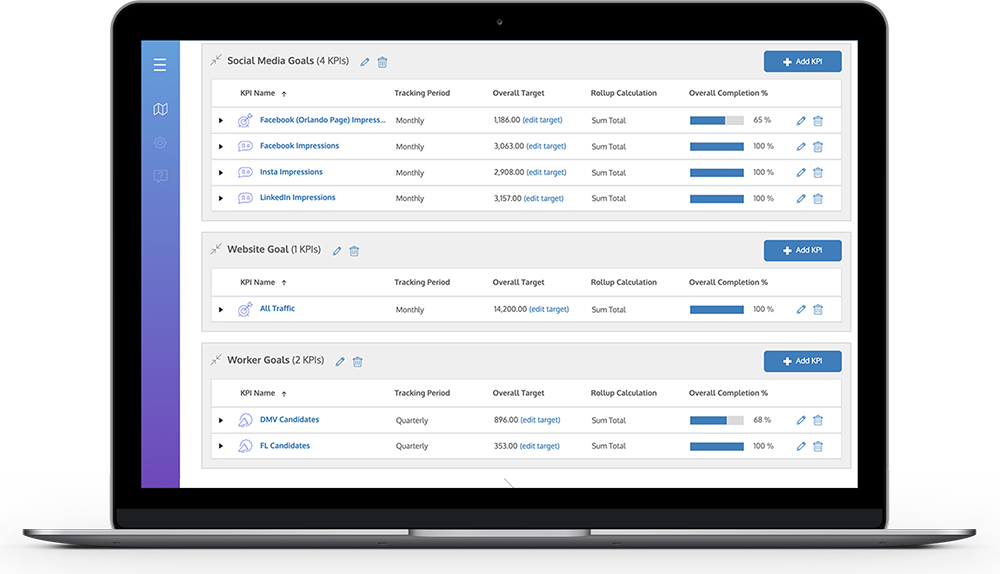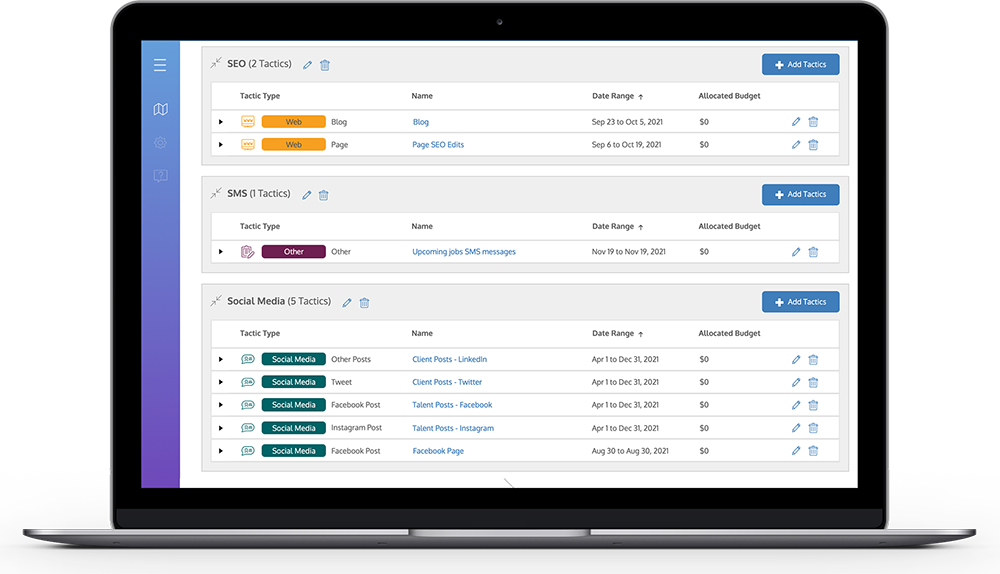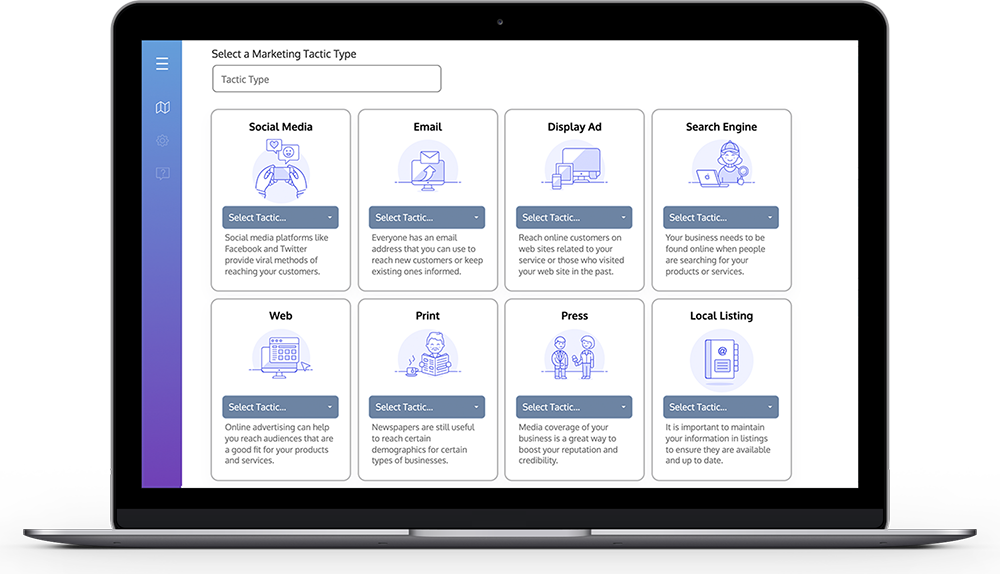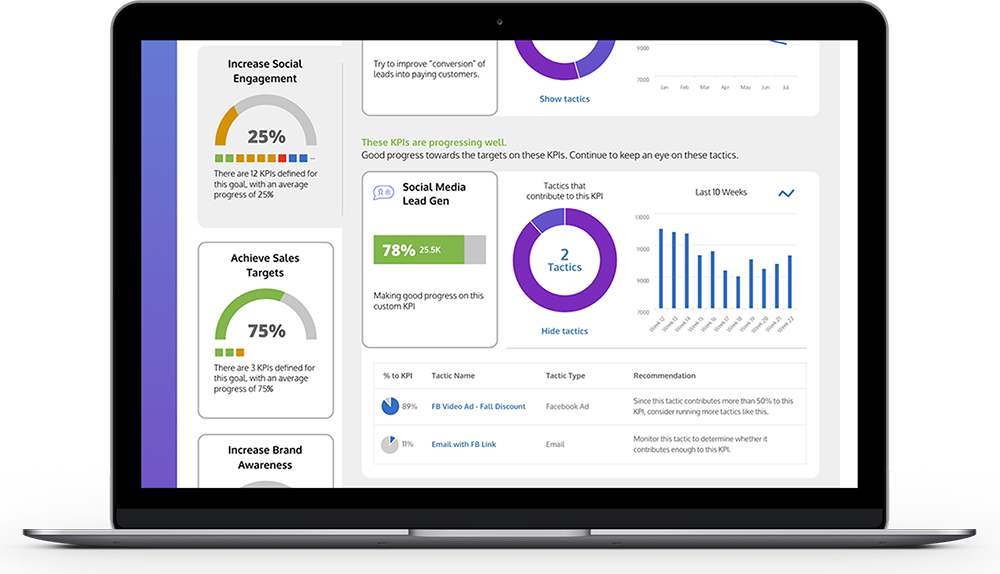How to Build a Marketing Plan for Any Size Business
(With Free Template and Marketing Software)
What is a marketing plan?
A marketing plan outlines a set of marketing directives that an organization will implement to create awareness for its brand and attract customers to reach its sales and revenue objectives.

A marketing plan is different from a business plan, which is a more holistic operational plan covering all aspects of a business. The marketing plan details marketing and business goals, how they will be measured, and the corresponding marketing campaigns and tactics to be undertaken to achieve those goals. Creating a marketing plan is easier than you might think, and benefits any type of business.
Are marketing plans only useful for large businesses?
Marketing plans are in fact important for businesses of any size. Unless you are in the enviable position of not needing new customers, your business will benefit from a marketing plan, even if you are a relatively small business.
Keep in mind that some marketing tactics, such as organic social media posts and online local listings, do not cost anything. Therefore, it is possible to have a fairly comprehensive marketing plan without a large budget. The most important aspects in a marketing plan are what goals you are trying to achieve and what tactics will be used to achieve them. Any business will benefit from such a plan, and smaller businesses with fewer resources will arguably benefit even more.
1 in 4 small businesses feel that digital marketing attracts new customers
Organized marketers are nearly 400% more likely to report success
Local businesses who are mature in marketing report twice as much revenue
Yet, 1 in 5 small businesses don't do any digital marketing
According to research, 75% of small businesses feel that digital marketing helps attract new customers, and local businesses who are mature in marketing generate twice as much revenue as those who are less marketing savvy. Unfortunately, as many as 1 out of 5 small businesses don’t do any digital marketing at all.
The primary reasons that small businesses struggle with marketing are...
● Lack of experience: 90% have immature marketing capabilities
● Lack of time: 50% spend less than 2 hours per week on marketing
● Poor planning: organizing marketing efforts is a top challenge
The good news is there are now plenty of useful small business marketing tools and services to help solve these issues. Marketrise is an example of a solution that provides you with a tailored marketing plan, recommended tactics, and will ultimately help you execute marketing tactics to meet your goals (or connect you with marketers who can do it for you). The most organized marketers are 397% more likely to report success, so there's really no reason to avoid starting with a marketing plan.
Marketing Strategy Basics
Before you dive into creating a detailed marketing plan, it is useful to have a basic marketing strategy. Marketers with a documented strategy are 313% more likely to report success. The key elements of a marketing strategy are understanding who your customers are, knowing who your top competitors are, and having a clear message that articulates your business value that resonates with customers.

Know your customers
● Who is your customer: are they individual customers or other businesses?● What are the characteristics of these customers: are they wealthy consumers, large businesses, etc.
● What is the main problem you are solving for your customer?
● For example: “businesses struggle to keep their offices clean on an ongoing basis”, or “there are no casual dining restaurants within this zip code that serve great Mexican food to families looking for a night out”.

Identify your competitors
● Who are the top competitors in your industry and geography? If you don’t know, this can often be determined by a google search for what you offer (eg. business cleaning services or mexican food in your region)● How is the digital presence of your top competitors? This can be determined by checking their website and social media accounts for offers, or seeing if they run any search ads on Google.

Have a clear message
● What is the basic “pitch” of your product or service? This message articulates the unique value proposition of your business: why should customers come to you. It should speak to the personas and problems identified in #1 above, and have some differentiation against the competitors identified in #2 above.● For example: “We provide the most sanitary workplace cleaning services at guaranteed schedules”, or “We serve great Mexican food in a family friendly atmosphere”
Create a Great Marketing Plan in 5 Steps
Marketing plans will vary depending on the size of your business, industry, customer type, and goals. The number of campaigns and activities in a plan will vary based on the type of business you run, the type of customers you serve, and the marketing budget available. However, all plans contain common elements and can be built following some simple steps…
1. Set Business Goals and KPIs
● All good plans start with simple, measurable goals (you can create goals following the SMART criteria)● Goal-setting marketers are 376% more likely to report success
● Creating a plan by starting with goals ensures that you focus your tactical efforts on helping you achieve specific business outcomes, rather than just do busy marketing work for the sake of it
● When creating goals, you will want to specify key performance indicators (KPIs) that help you measure your progress against the goals
● For example, here is a goal supported by two KPIs:
GOAL: Generate Marketing Leads
KPI 1: Web Site Visitors (with specific monthly or quarterly web visitors)
KPI 2: Leads (monthly conversion of visitors to a lead)

Once you have goals and KPIs defined, marketing tactics should contribute towards these KPIs, to help you hit your goals
2. Determine Campaign Projects
● Campaigns are like marketing “projects” that contain multiple tactics and activities● Marketers who proactively plan projects are 356% more likely to report success
● A campaign is typically centered around a specific marketing channel (like social media) or around a specific marketing objective (like launching a new product)
● When first creating a plan, it helps to think of the high-level campaigns before creating tactics
● For example, here are a few campaigns that might be included in a marketing plan:
CAMPAIGN 1: Social Media Marketing
CAMPAIGN 2: Email Marketing
CAMPAIGN 3: Customer Loyalty Campaign
 Once you have a plan with Goals and and outline of the Campaigns, you can start to flesh it out with budget and tactics. Once you have goals and KPIs defined, marketing tactics should contribute towards these KPIs, to help you hit your goals
Once you have a plan with Goals and and outline of the Campaigns, you can start to flesh it out with budget and tactics. Once you have goals and KPIs defined, marketing tactics should contribute towards these KPIs, to help you hit your goals
3. Specify Budget
● It helps to have a sense of budget before you start thinking about specific marketing tactics within your campaigns● The amount of budget you allocate to various campaigns will dictate how much you can spend in those areas
● You can start by specifying an overall budget for the plan, and then allocate portions of that budget to each individual campaign
● This budget allows you to invest in specific marketing tactics that generate results, which are tied to Goals and KPIs
● For example:
BUDGET: $5,000
CAMPAIGN 1 Budget: $2,000
CAMPAIGN 2 Budget: $2,000
CAMPAIGN 3 Budget: $1,000
 Once you have a high level budget allocation, you can start to create the plan details,
Once you have a high level budget allocation, you can start to create the plan details,
4. Create Tactics and Activities
● Tactics and their corresponding Activities are the heart of the marketing plan and campaigns● A tactic is a specific marketing action such as a Facebook ad or email blast
● Tactics consist of one or more activities or tasks that have to happen in order to fully complete the tactic
● Tactics can be funded with budget from the campaign
● A tactic will ideally generate results that contribute towards one or more Goals and KPIs
● For example:
CAMPAIGN 1: Social Media Marketing
TACTIC 1: Facebook Ad - Spring Discount
ACTIVITY 1: Create ad content (this is a task)
ACTIVITY 2: Create landing page (this is a task)
ACTIVITY 2: Approve content (this is a task)
ACTIVITY 3: Run Facebook ad (this is the actual ad)
KPI Result 1: 200 Web Site Visitors in March
KPI Result 2: 15 Leads in March
BUDGET: $350
 Now that you've set up your tactics and activities, you can launch set your plan in motion, and start to track the results.
Now that you've set up your tactics and activities, you can launch set your plan in motion, and start to track the results.
5. Track Results and Improve Performance
● Once your marketing plan is underway, you will be running the tactics and tracking the results against your goals and KPIs● 70% of the most organized marketers achieve their goals most of the time, while an elite 10% of organized marketers Always achieve them
● By setting up the plan this way, you will be able to see which tactics and campaigns are contributing the most to your goals
● Once you have enough results by trying various tactics, you can start to focus and double down on those tactics which seem to be yielding the best results for the money
● This allows you to improve your marketing return on investment (ROI) over time, by focusing on the tactics that are most effective at helping you achieve your business goals

Now that you understand the fundamentals and benefits of a marketing plan, you can get started improving your marketing results by instantly creating a powerful marketing plan from a template or guided wizard: sign up to Marketrise for free.
